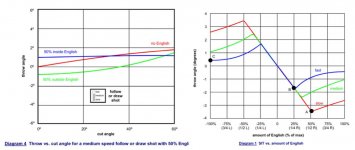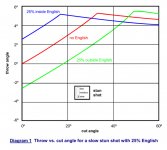View attachment 528683
This diagram graphs a soft stun shot using 25% outside, 25% inside english and comparing the throw to a center ball stun shot without english. The focus of what this tells us about center ball is what started my journey. Look at the red no english line in the diagram. A simple center ball shot without any spin and the amounts of deviation from the physics elastic model termed ghost ball reveals a problem.
Throw with slow speed, center ball cueing, in just the half of the ball from a straight in shot through a half ball shot, which is about 30°, varies from zero throw to over 5.5° of deviation, with clean balls in a test lab. This represents the majority of angles a player shoots.
Games like 8 ball and straight pool have been primarily played on smaller tables with generous pockets. The nature of the games means that shots longer than ½ a table are infrequent. The forgiveness factor meant that for decades cut induced throw was handled by applying a little outside side to counter it. Many early tables also had nap, lessening the deflection factor and increasing deflection cancelling swerve.
Modern equipment with shaved nap surfaces and the addition of 9 foot tables as a more frequent standard has changed things. The rotation games that have become popular are played on larger tables and longer shots are more prevalent. The effect of throw has become a problem in these modern games.
The center ball thesis for expert play should now be in question. As a beginner base it has merit and what players learn need not be forgotten or thrown out. That said the thesis for cueing a significant number of shots with small amounts of convergent english has merit. Actual table use has found the method quite forgiving and it has the benefit of limiting throw and making the throw element more consistent across a large range of shots.
Players using some outside english in the past often just lined up the center ball shot and tweaked the shot a bit with some back hand english to the outside. The resultant cue line was a slight overcut compared to the ghost ball and a bit of deflection compensated. The net effect was a better result than using pure center ball on most shots. The data presented here shows, in fact, that any shot using top or bottom and a firm stroke had less throw when outer side spin was added. The gearing english thesis worked even if the shooter didn’t get the throw cancelation exactly right, it lessened net throw.
The result though in most cases has been an exaggeration of object ball contact off the natural acquisition of outside english by the collision. The cue ball pace was either deadened or sped up more off rail contact. The rebound angle is either flattened or sharpened when intentional outside english has been added. Cue ball control became more difficult. In order to solve the problem of the uneven travel of the cue ball when it contacts a rail, the side limiting thesis of center ball striking gets recycled. Now the position control issue becomes a pocketing issue due to throw instead.
Intentional off center hits have a forgiveness factor not available to center ball. Center ball has no adjustment to the aim line included to catch an off center hit. If the off center hit is planned a preshot adjustment can be made. If the off center stroke is planned and encounters a subsequent slightly larger off center hit, part of the effect has already been compensated for in preshot adjustments.
Try the following. Set a ball mid table in line with the table center. Put the cue ball on the spot. Cue the center table ball dead on. In theory it should, with a straight stroke rebound off the end cushion and return to hit the cue ball flush. Try it 10 times. What is the actual result? This mid a multi-trial attempt. The results should be higher than in actual play where "do overs" are not commonplace. The point is that less than perfect cueing is common and that proactively building in a forgiveness factor based on physics makes sense.
This is not a thesis to throw out what we have all learned. It’s about a new tool in the toolbox. A new way of harnessing side to improve pocketing error management through minimizing the effects of throw, is just one aspect. Countering the negative effects of acquired outside side when rail contact, makes judgement of speed and angles off the rail, more consistent. It also gives the player who has been using outside to compensate for throw issues, an alternative, that doesn’t involve losing cue ball control in the process.
Center ball needs a reality check and a new tool in the toolbox is just a tool. Players have been using the outside spin to counteract the throw issue for decades and just trading one problem for another. By learning to apply side convergently a different set of interactions are set in motion. An alternative option is available. The example using convergent inside english has proven to be a better solution to counteracting throw except where outsidevenglish is needed to alter the angle off a rail or added speed is better achieved with doin than pace.
I’ve focused on convergent inside so far but there is a whole world of convergent outside to consider as well. This should be enough grist for the mill to grind for tonight.



